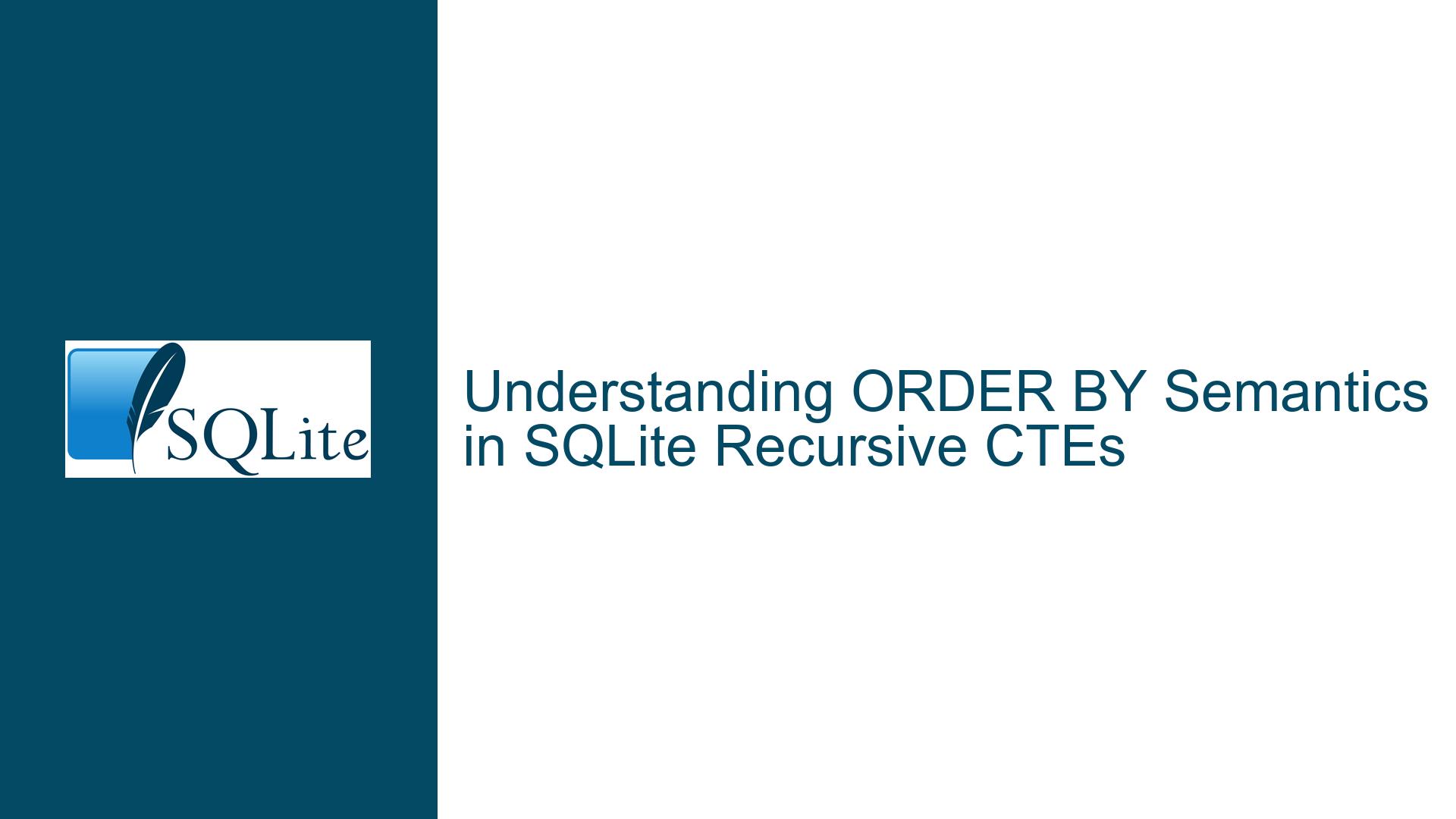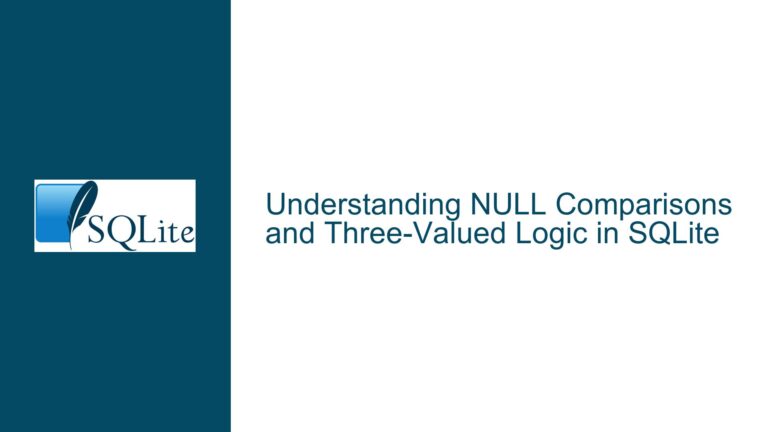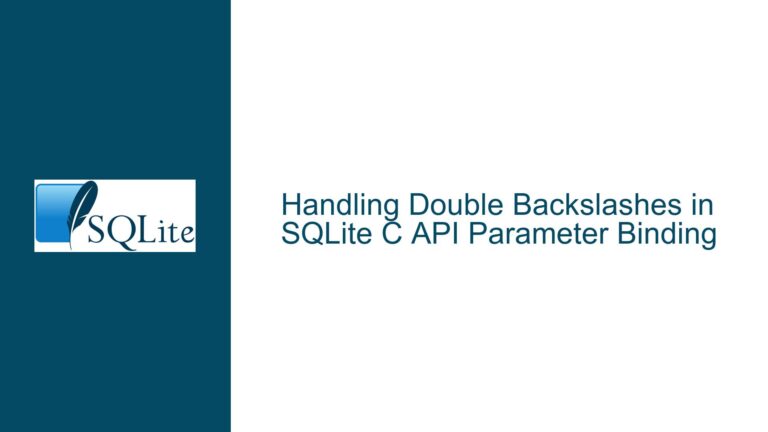ORDER BY Semantics in SQLite Recursive CTEs
Recursive CTE Processing Order: How ORDER BY Affects Queue Management and Result Generation
Issue Overview: The Interaction Between ORDER BY and Recursive Query Execution
Recursive Common Table Expressions (CTEs) in SQLite implement a breadth-first search algorithm by default, but their behavior becomes nuanced when combined with ORDER BY clauses. The core issue revolves around understanding when and how sorting operations affect:
- The processing order of rows in the recursive queue
- The final result set ordering
- The generation path of hierarchical data
A recursive CTE operates through iterative cycles where each iteration processes rows from a working queue. The ORDER BY clause in the recursive part of the CTE directly controls the sequence in which rows are extracted from this queue for processing. This differs fundamentally from a top-level ORDER BY that merely sorts final results, as demonstrated in the binary string generation example where changing the CTE’s sort direction alters the pattern of string construction rather than just output arrangement.
Three critical execution phases are impacted:
- Queue population: How initial and recursive rows enter the processing queue
- Row extraction: The order in which queued rows become input for subsequent iterations
- Result accumulation: How intermediate results get stored before final output
Misunderstanding these phases leads to common pitfalls like:
- Unexpected generation patterns in hierarchical data
- Incomplete traversal when using LIMIT without proper ordering
- Performance degradation from unnecessary sorting operations
Possible Causes: Execution Plan Divergence Through Sorting Directives
1. Recursive Processing Queue Management
SQLite implements recursive CTEs using a temporary in-memory queue that stores rows awaiting processing. The presence of an ORDER BY clause in the recursive part of the CTE transforms this from a simple FIFO queue (breadth-first behavior) into a priority-sorted queue. Each new batch of rows added to the queue gets merged into the existing sorted structure rather than appended to the end.
This implementation detail explains why changing sort direction in the CTE produces completely different generation patterns in the binary string example. An ASC sort processes shorter strings first at each length tier, while DESC prioritizes ‘1’-based strings earlier, altering the expansion path through the possible combinations.
2. Final Output Ordering vs. Generation Ordering
The confusion between these two ordering contexts manifests when developers:
a) Apply ORDER BY at the CTE level expecting final output sorting
b) Use top-level ORDER BY hoping to control generation order
In reality:
- CTE-level ORDER BY dictates processing sequence during recursion
- Top-level ORDER BY applies a final sort to completed results
This distinction becomes critical when using LIMIT or when recursive depth affects result validity. A CTE processing order that prioritizes certain paths may never generate some potential results if terminated early.
3. Sorting Algorithm Efficiency Characteristics
SQLite’s implementation maintains the queue in sorted order through efficient insertion rather than full re-sorts. When a new row enters the queue:
- The database engine identifies its correct position based on current ORDER BY criteria
- The row gets inserted directly into that position
- Subsequent extractions always remove the first/last element based on sort direction
This approach maintains O(n log n) time complexity for queue operations rather than O(n²) for naive re-sorting. However, developers must recognize that even this optimized approach carries higher overhead than unsorted queue management.
Troubleshooting Methodology: Diagnosing and Resolving Order-Sensitive Recursion
Step 1: Analyze the Query’s Generation Requirements
Scenario A: Order-independent result generation
- Use no CTE-level ORDER BY
- Apply sorting only at the top level
- Example: Generating all possible combinations where sequence doesn’t affect completeness
Scenario B: Order-dependent generation path
- CTE-level ORDER BY required
- Use when:
- Implementing depth-first search patterns
- Prioritizing certain branches in hierarchical data
- Optimizing for early termination with LIMIT
Diagnostic Check: Run the query with/without CTE-level ORDER BY while keeping the top-level sort constant. If result contents differ (not just order), generation is order-sensitive.
Step 2: Examine the Execution Plan with EXPLAIN
Use SQLite’s EXPLAIN command to observe how sorting directives affect bytecode generation:
EXPLAIN
WITH RECURSIVE test(n) AS (
SELECT 1
UNION ALL
SELECT n+1 FROM test ORDER BY n DESC LIMIT 5
)
SELECT * FROM test;
Key opcodes to observe:
- SorterOpen (indicates sorting operations)
- Rewind/Next loops (processing order indicators)
- Sequence counters (row generation patterns)
A CTE with ORDER BY will show explicit sorting opcodes in the recursive branch, while unsorted CTEs utilize simpler queue management.
Step 3: Validate Through Controlled Experiments
Test 1: Depth-First vs Breadth-First Generation
-- Breadth-first (default)
WITH RECURSIVE hierarchy(id, parent, level) AS (
SELECT 1, NULL, 1
UNION ALL
SELECT t.id, h.id, h.level+1
FROM source_table t
JOIN hierarchy h ON t.parent = h.id
-- No ORDER BY
)
SELECT * FROM hierarchy;
-- Depth-first
WITH RECURSIVE hierarchy(id, parent, level) AS (
SELECT 1, NULL, 1
UNION ALL
SELECT t.id, h.id, h.level+1
FROM source_table t
JOIN hierarchy h ON t.parent = h.id
ORDER BY level DESC -- Forces depth-first
)
SELECT * FROM hierarchy;
Test 2: Early Termination Behavior
-- Returns 5 shortest paths
WITH RECURSIVE paths(path) AS (
SELECT 'A'
UNION ALL
SELECT path || '->' || node
FROM graph, paths
WHERE current_node = last_node
ORDER BY LENGTH(path) ASC
)
SELECT path FROM paths LIMIT 5;
-- Returns 5 arbitrary paths (may be longer)
WITH RECURSIVE paths(path) AS (
SELECT 'A'
UNION ALL
SELECT path || '->' || node
FROM graph, paths
WHERE current_node = last_node
)
SELECT path FROM paths LIMIT 5;
Step 4: Implement Corrective Measures Based on Findings
Solution 1: Decoupling Generation Order from Output Order
When generation requires specific ordering but final output needs different sorting:
WITH RECURSIVE generated AS (
-- CTE with generation-order sorting
SELECT ...
ORDER BY generation_priority
)
SELECT *
FROM generated
ORDER BY presentation_order; -- Separate top-level sort
Solution 2: Optimizing for Partial Result Extraction
For queries needing early termination with LIMIT while ensuring priority results:
WITH RECURSIVE prioritized AS (
SELECT data, priority
FROM initial
UNION ALL
SELECT new_data, new_priority
FROM next_step, prioritized
ORDER BY priority DESC -- Highest priority first
)
SELECT data
FROM prioritized
LIMIT 100; -- Get top 100 by priority
Solution 3: Avoiding Redundant Sorting Operations
When both CTE and top-level use similar ORDER BY:
-- Inefficient double sort
WITH RECURSIVE temp AS (
...
ORDER BY col1
)
SELECT * FROM temp ORDER BY col1;
-- Optimized version
WITH RECURSIVE temp AS (
...
-- Omit CTE sort if final sort matches
)
SELECT * FROM temp ORDER BY col1;
Step 5: Advanced Pattern Handling
Pattern 1: Tiered Ordering
Process groups of rows in specific priority tiers:
WITH RECURSIVE process AS (
SELECT id, 'TIER1' AS priority FROM initial
UNION ALL
SELECT t.id,
CASE WHEN condition THEN 'TIER1' ELSE 'TIER2' END
FROM process p
JOIN source t ON ...
ORDER BY
CASE priority
WHEN 'TIER1' THEN 1
ELSE 2
END,
secondary_sort
)
SELECT * FROM process;
Pattern 2: Multi-Column Sort Dependencies
When sort order depends on multiple columns with different directions:
WITH RECURSIVE sorted AS (
SELECT x, y
FROM points
UNION ALL
SELECT x+dx, y+dy
FROM movements, sorted
ORDER BY x DESC, y ASC -- Primary x descending, secondary y ascending
)
SELECT * FROM sorted;
Pattern 3: Dynamic Sorting Based on Recursive State
Alter sort criteria mid-recursion through computed columns:
WITH RECURSIVE adaptive AS (
SELECT 1 AS phase, data
UNION ALL
SELECT
CASE WHEN some_condition THEN 1 ELSE 2 END,
new_data
FROM adaptive
ORDER BY
phase,
CASE phase
WHEN 1 THEN sort_column1
ELSE sort_column2
END
)
SELECT * FROM adaptive;
Final Implementation Checklist
Generation Order Validation
- Does changing the CTE’s ORDER BY alter the result contents (not just order)?
- Are all required result paths being explored given LIMIT clauses?
Performance Benchmarking
- Compare EXPLAIN output with/without CTE-level sorts
- Measure memory usage for large queues with different sort criteria
Result Completeness Testing
- Run with LIMIT removed to ensure all expected results appear eventually
- Verify sort stability across multiple executions
Documentation Alignment
- Annotate queries explaining why particular sort orders were chosen
- Cross-reference with SQLite’s documentation on recursive CTE semantics
By systematically applying this troubleshooting methodology, developers can precisely control recursive query behavior, optimize performance characteristics, and ensure reliable result generation across varying dataset sizes and structural complexities.






